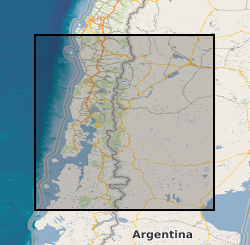Diatoms
Type of resources
Available actions
Topics
Keywords
Contact for the resource
Provided by
Years
Update frequencies
-

Stratigraphic and ecological data from tidal marsh sites in south-central Chile. Includes stratigraphy, diatom assemblages and radiocarbon dates from fossil cores and diatom assemblages from modern tidal marsh samples. Data were collected to provide evidence for multiple great earthquakes in south-central Chile, and enable the reconstruction of vertical land-level changes associated with these earthquakes. Data are from tidal marsh sites within the 1960 earthquake rupture area along the Chilean subduction zone (37.5 - 46 degrees South).
-
This dataset presents the relative diatom abundances of 55 species/groups from the 132-120 ka interval in marine sediment core NBP9802-04 (-64.20 degN, -170.08 degE). This age interval corresponds to the peak of Marine Isotope Stage 5e (130- 116 ka). Microscope slides were prepared using a method adapted from Scherer (1994) and 300+ diatom valves were counted for each depth sample to produce the relative percentage abundance of each diatom species/group. This project was funded by the UK Natural Environment Research Council Grant NE/L002531/1
-
This dataset presents the relative diatom abundances of 55 species/groups from the 132-120 ka interval in marine sediment core TPC287 (-60.31 degN, -36.65 degE). This age interval corresponds to the peak of Marine Isotope Stage 5e (130- 116 ka). Microscope slides were prepared using a method adapted from Scherer (1994) and 300+ diatom valves were counted for each depth sample to produce the relative percentage abundance of each diatom species/group. This project was funded by the UK Natural Environment Research Council Grant NE/L002531/1
-
This dataset presents the relative diatom abundances of 55 species/groups from the 132-120 ka interval in marine sediment core TPC288 (-59.14 degN, -37.96 degE). This age interval corresponds to the peak of Marine Isotope Stage 5e (130- 116 ka). Microscope slides were prepared using a method adapted from Scherer (1994) and 300+ diatom valves were counted for each depth sample to produce the relative percentage abundance of each diatom species/group. This project was funded by the UK Natural Environment Research Council Grant NE/L002531/1
-
This dataset presents the relative diatom abundances of 56 species/groups from the 132-120 ka interval in marine sediment core U1361A (-64.41 oN, 143.89 oE). This age interval corresponds to the peak of Marine Isotope Stage 5e (130- 116 ka). Microscope slides were prepared using a method adapted from Scherer (1994) and 300+ diatom valves were counted for each depth sample to produce the relative percentage abundance of each diatom species/group. This project was funded by the UK Natural Environment Research Council Grant NE/L002531/1
-
This dataset presents the relative diatom abundances of 55 species/groups from the 132-120 ka interval in marine sediment core TPC290 (-55.55 degN, -45.02 degE). This age interval corresponds to the peak of Marine Isotope Stage 5e (130- 116 ka). Microscope slides were prepared using a method adapted from Scherer (1994) and 300+ diatom valves were counted for each depth sample to produce the relative percentage abundance of each diatom species/group. This project was funded by the UK Natural Environment Research Council Grant NE/L002531/1
-
This dataset presents the relative diatom abundances of 56 species/groups from the 132-120 ka interval in marine sediment core PC509 (-68.31 degN, -86.03 degE). This age interval corresponds to the peak of Marine Isotope Stage 5e (130- 116 ka). Microscope slides were prepared using a method adapted from Scherer (1994) and 300+ diatom valves were counted for each depth sample to produce the relative percentage abundance of each diatom species/group. This project was funded by the UK Natural Environment Research Council Grant NE/L002531/1
-
This dataset presents the relative diatom abundances of 55 species/groups from the 132-120 ka interval in marine sediment core MD03-2603 (-64.28 degN, 139.38 degE). This age interval corresponds to the peak of Marine Isotope Stage 5e (130- 116 ka). Microscope slides were prepared using a method adapted from Scherer (1994) and 300+ diatom valves were counted for each depth sample to produce the relative percentage abundance of each diatom species/group. This project was funded by the UK Natural Environment Research Council Grant NE/L002531/1
-
A new version of this dataset is now available: Chadwick, M., & Allen, C. (2021). Marine Isotope Stage 5e diatom assemblages in marine sediment core ANTA91-8 (-70.78 degN, 172.83 degE, Cruise ANTA91) - VERSION 2 (Version 2.0) [Data set]. NERC EDS UK Polar Data Centre. https://doi.org/10.5285/BDA782A6-E89A-41A6-8791-F28001BC5D11 This dataset presents the relative diatom abundances of 56 species/groups from the 132-120 ka interval in marine sediment core ANTA91-8 (-70.78 degN, 172.83 degE). This age interval corresponds to the peak of Marine Isotope Stage 5e (130-116 ka). Microscope slides were prepared using a method adapted from Scherer (1994) and 300+ diatom valves were counted for each depth sample to produce the relative percentage abundance of each diatom species/group. This project was funded by the UK Natural Environment Research Council Grant NE/L002531/1.
-
This dataset presents the relative diatom abundances of 55 species/groups from the 132-120 ka interval in marine sediment core ELT17-9 (-63.08degN, -135.12 degE). This age interval corresponds to the peak of Marine Isotope Stage 5e (130-116 ka). Microscope slides were prepared using a method adapted from Scherer (1994) and 300+ diatom valves were counted for each depth sample to produce the relative percentage abundance of each diatom species/group. This project was funded by the UK Natural Environment Research Council Grant NE/L002531/1
 NERC Data Catalogue Service
NERC Data Catalogue Service